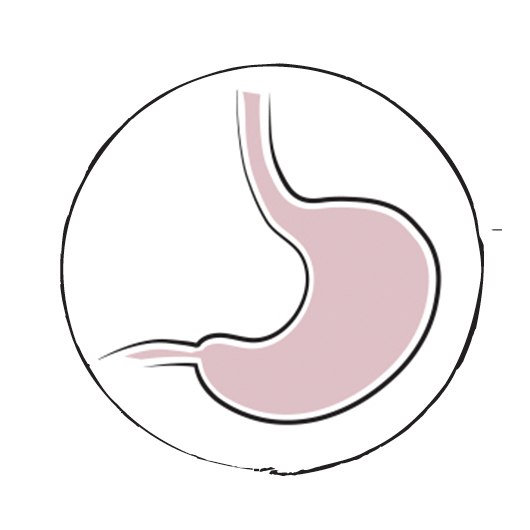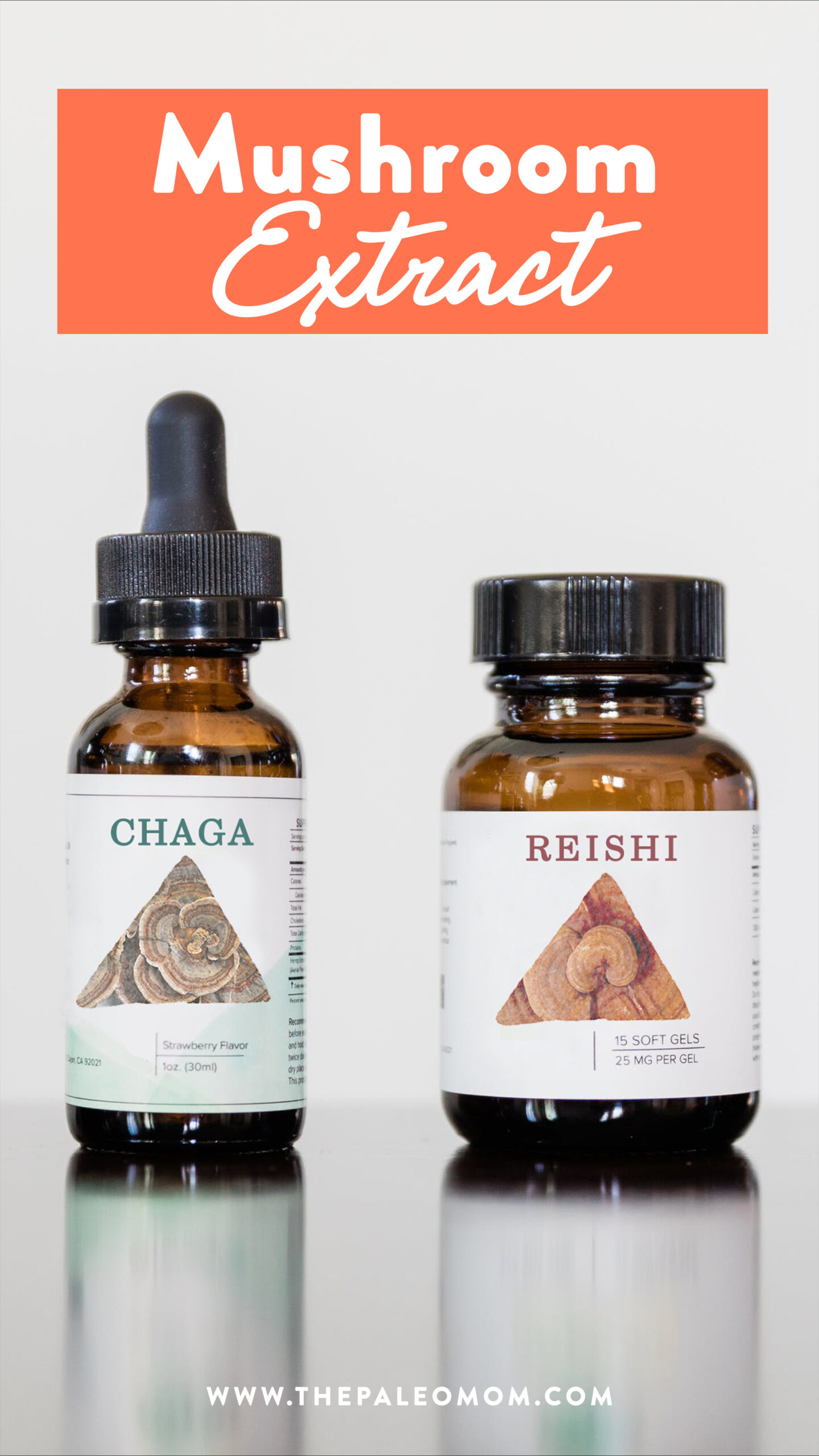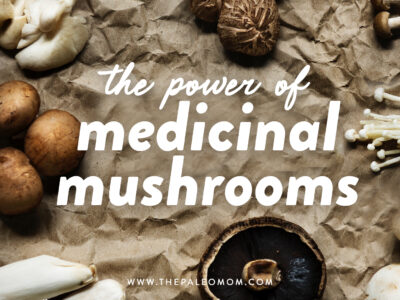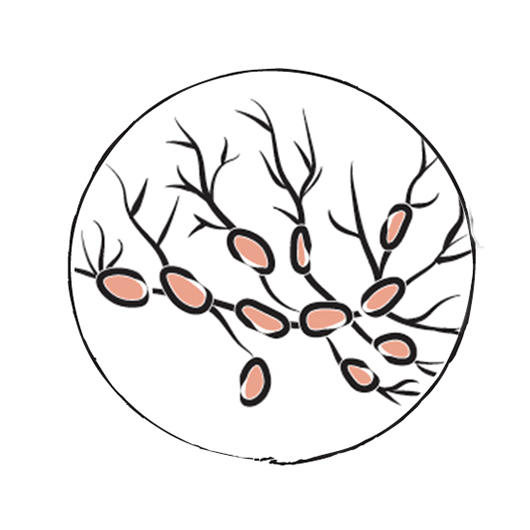 Mushrooms are an incredibly valuable nutrient-dense food that offers our gut bacteria unique fiber types that we can’t get from any other food (see Elevating Mushrooms to Food Group Status and What Is the Gut Microbiome? And Why Should We Care About It?). But recent trends have also started to discuss the power of medicinal mushrooms, a subcategory of fungi that, in addition to being a tasty nutrient-dense food, have known medical benefits. Are these fungi worth all the Internet hype? In short: Yes! In this post, I’ll be giving an overview of some of the scientifically-proven benefits of medicinal mushrooms.
Mushrooms are an incredibly valuable nutrient-dense food that offers our gut bacteria unique fiber types that we can’t get from any other food (see Elevating Mushrooms to Food Group Status and What Is the Gut Microbiome? And Why Should We Care About It?). But recent trends have also started to discuss the power of medicinal mushrooms, a subcategory of fungi that, in addition to being a tasty nutrient-dense food, have known medical benefits. Are these fungi worth all the Internet hype? In short: Yes! In this post, I’ll be giving an overview of some of the scientifically-proven benefits of medicinal mushrooms.
Table of Contents[Hide][Show]
Medicinal mushrooms have been used in traditional medicine for centuries. Unlike some other techniques and products in the alternative medical community, medicinal mushrooms are extraordinarily well-studied and validated to have medical benefits. You may have heard that medicinal mushrooms are great for our immune system, but did you know that they can also improve our blood sugar, help maintain a healthy cardiovascular system, and combat fatigue? We’ll get to the juicy stuff, but, of course, I want to start with the basics.
What Counts as a Medicinal Mushroom?
Mushrooms are the fruiting body of a fungus. Fungi are a unique class of organism (technically they’re own kingdom!) that play an important role in all ecosystems, especially as contributors to the decay and recycling of plant and animal matter. Mushrooms are well-studied for their unique compounds that contribute to this unique ability to digest other types of organisms.
Medicinal mushrooms are deemed as such because they’ve been studied for their ability to improve or sustain health; current estimates are that there are approximately 700 species of mushrooms with medicinal properties! That being said, not all of these species have rigorous science backing them up (at least for now). There are several well-established medicinal mushroom species that have been used by traditional cultures, especially in Asia but also including regions in Eastern Europe and Africa, and that have been well-studied in the scientific literature. These include:
- Reishi (Ganoderma lucidum)
- Shiitake (Lentinus edodes)
- Chaga (Inonotus obliquus)
- Lion’s Mane (Hericium erinaceus)
- Turkey Tail (Trametes versicolor)
- Cordyceps (Cordyceps sinensis)
Of course, this is just a small sample of the approximately 14,000 species of mushrooms (and estimated 500,000 to 10 million species of fungi around the globe). So, the handful of well-studied medicinal mushrooms may be just the tip of the iceberg, medically!
The Known Physiological Effects of Medicinal Mushrooms
There are many known physiological benefits of medicinal mushrooms. Here is a breakdown of all of the established ways that medicinal mushrooms can influence our health:
Immune System.
This may be the best-known mechanism behind the health effects of medicinal mushrooms, as there has been a lot of press about the anti-tumor and immunomodulating effects. But, that isn’t all! Several physiological actions have been identified as additional ways that these potent mushrooms influence our immune function.
- Antitumor: The polysaccharides in over 30 medicinal mushroom species have been shown to prevent tumor formation, exhibit direct anti-tumor activity, and prevent metastasis (spreading of cancer from the original organ to another location/organ system). Specifically, studies have shown that these effects are most potent when combined with chemotherapy – and importantly, it’s safe to implement both at the same time! This activity is modulated by T cells, so a person must have an intact T cell system and thymus.
- Immunomodulating: Components of medicinal mushrooms have been shown to induce genetic expression that leads to the creation of a variety of immunomodulatory cytokines and cytokine receptors. This allows for the immune system to respond appropriately to stressors (and helps to dampen inappropriate inflammation).
- Antioxidant & Radical Scavenging: Antioxidants and radical scavengers are compounds capable of neutralizing free radicals and oxidated compounds in the body. Antioxidants also work within systems of enzymes in the liver that are important for detoxification and elimination. Compounds in medicinal mushrooms have been shown to have potent antioxidant capacity, which certainly contributes to their antitumor and anti-inflammatory qualities.
- Antibacterial, Antiparasitic, & Antifungal: Some studies are now comparing the antimicrobial activity of medicinal mushrooms with that of pharmaceutical antibiotics! Current thinking is that mushrooms require their own antimicrobial properties to stay vital in the wild, and humans that consume medicinal mushrooms get some of those benefits. Interestingly, studies are now showing that shiitake mushrooms may been an antimicrobial agent in cases of treatment-resistant and otherwise tricky infections like shigella and E. coli O157:H7.
- Anti-Inflammatory: Several of the above categories certainly count as anti-inflammatory, but I wanted to highlight that medicinal mushrooms are considered potent general anti-inflammatories. Several medicinal mushroom polysaccharides have been demonstrated to have anti-inflammatory activity, including terpenoids, phenols, polysaccharides, and proteoglucans. If you’ve read The Amazing World of Plant Phytochemicals, then some of these words are familiar! Yes, there is definitely some crossover between our nutrient-dense plant friends and our nutrient-dense fungi friends!
Nutrivore Weekly Serving Matrix
An easy-to-use and flexible weekly checklist
to help you maximize nutrient-density.
The Weekly Serving Matrix is very helpful! I’ve been eating along these lines but this really helps me know where to focus vs. which foods serve a more secondary role. It’s super helpful and has taken a lot of worry out of my meal planning. Thanks!
Jan
Let’s take a moment to highlight what this might mean for management of autoimmune diseases and discuss some of the more nuanced concepts in more detail. Some beta-glucans (fibrous components of mushrooms that can be potently bioactive) are very small molecules, so they can actually bind to immune cells directly, thereby affecting immune activity in addition to the indirect effects mediated by the gut microbiome. This fact provided the original rationale for avoiding medicinal mushroom extracts on the Autoimmune Protocol. Autoimmune disease sufferers must necessarily be wary of any substance that stimulates the immune system. However, newer studies reveal medicinal mushrooms are more likely immunomodulatory (bringing balance back to an imbalanced immune system) rather than immunostimulatory. Reishi is the best studied in this regard.
Two studies in rheumatoid arthritis patients showed decreased joint pain concurrent with a decrease in interleukin(IL)-18, which very potently activates Th1 cells (there was also no increase in any measured inflammatory cells or other cytokines). One mouse study of lupus demonstrated that reishi extract supplementation caused a decrease in autoantibodies and increasedsurvival. A subsequent mouse lupus study showed that reishi increased the ratio of regulatory T cells to Th17 and Th1 cells with concurrent changes in cytokines, including decreases in IL-21, IL-10 and IL-17 and increases in IL-2 and IL-12P70. Finally, a mouse model of autoimmune Alzheimer’s disease showed changes in gene expression that correlated with reduced disease activity thanks to reishi supplementation. The fascinating context here is that reishi extract is also beneficial in cancer, in that case increasing the activity of cytotoxic T cells (in addition to affecting tumor angiogenesis and cancer cell growth directly).
The picture these data paint is one of medicinal mushroom extracts (at least in the case of reishi) being beneficial in instances of under-active immune systems (such as in common cold and flu season), overactive immune function (such as in cases of autoimmune diseases), and carcinogenesis (such as in the growth of tumors and metastatic cancers). While whole medicinal mushrooms (like shiitake, which is pretty easy to find in grocery stores) are included on the Autoimmune Protocol, there is clearly a great need for additional research to confirm this before reishi and other medicinal mushroom extracts earn the explicit go-ahead in autoimmune disease sufferers. For now, medicinal mushroom extracts should be considered an AIP gray area.
Cardiovascular System.

Medicinal mushrooms are also known to help our cardiovascular system. As with the immune system, there are studies supporting preventative benefit as well as support for combating diseases. Species of medicinal mushrooms have been shown to treat arrhythmias, ischemic heart disease (the most common cause of heart attacks, by the way!), and chronic heart failure. Part of the established mechanism for these benefits in heart disease is that medicinal mushrooms’ anti-inflammatory traits increase blood vessel dilation and circulation to the heart. These effects are also true for circulation to the brain!
It also appears that supplementation with medicinal mushrooms, especially cordyceps, lowers total cholesterol, LDL cholesterol (that’s the bad kind), and triglycerides. Likewise, they improve blood pressure and inhibit platelet aggregation time (preventing plaques), which can be very helpful in the prevention of heart disease. See also The Paleo Diet for Cardiovascular Disease.
Respiratory System.
Several medicinal mushrooms have been studied in clinical trials related to lung health, and there are traditional uses for lung conditions as well. For example, cordyceps has been used for centuries to treat chronic respiratory disorders, including asthma and chronic bronchitis. This use has been confirmed in studies of patients with asthma, specifically when participants use the mushroom for 5-6 weeks. Another study specifically investigated the effect of cordyceps on patients with non-small cell lung cancer (stages I to III) and found benefit. See also Paleo for Asthma and Allergies.
Endocrine System.
 One of the best-studied ways that medicinal mushrooms impact our health is that they improve blood sugar regulation. The mechanism for this appears to be that mushrooms supply amazing prebiotics (AKA food for our gut microbiome) that support a healthy gut. Believe it or not, blood sugar regulation is hugely dependent on our gut health and isn’t just about the amount of total sugar and carbohydrates we consume over time. That being said, eating whole medicinal mushrooms and/or powdered whole medicinal mushrooms is essential to get the full benefit here – but you get the awesome double whammy of the nutrients as well as the unique fiber found in many mushrooms called chitin. (See also The Hormones of Fat: Leptin and Insulin, The Case for More Carbs: Insulin’s Non-Metabolic Roles in the Human Body and 3 Ways to Regulate Insulin that Have Nothing to Do With Food)
One of the best-studied ways that medicinal mushrooms impact our health is that they improve blood sugar regulation. The mechanism for this appears to be that mushrooms supply amazing prebiotics (AKA food for our gut microbiome) that support a healthy gut. Believe it or not, blood sugar regulation is hugely dependent on our gut health and isn’t just about the amount of total sugar and carbohydrates we consume over time. That being said, eating whole medicinal mushrooms and/or powdered whole medicinal mushrooms is essential to get the full benefit here – but you get the awesome double whammy of the nutrients as well as the unique fiber found in many mushrooms called chitin. (See also The Hormones of Fat: Leptin and Insulin, The Case for More Carbs: Insulin’s Non-Metabolic Roles in the Human Body and 3 Ways to Regulate Insulin that Have Nothing to Do With Food)
You may have already seen my in-depth series on adrenal fatigue, called Demystifying Adrenal Fatigue. I actually mention multiple mMedicinal mushrooms in the third post, Nutritional and Lifestyle Support for the Adrenal Glands! Specifically, I include reishi and cordyceps in that article – go check it out if you think you might be experiencing adrenal fatigue! Studies have shown that cordyceps can help with maintaining hormonal homeostasis and may improve adrenal function.
Believe it or not, medicinal mushrooms have also been studied to help with sexual function. Randomized controlled trials have demonstrated that medicinal mushrooms can increase libido and improve male sexual dysfunction.
Detoxification & Elimination (AKA Kidney, Liver, and, of course, Gut Health!!).
 Mushrooms have long been used in China for benefits for chronic kidney diseases like chronic nephritis and kidney failure (see also The Paleo Diet for Kidney Disease). Medicinal mushrooms have been linked with proper water balance, which helps in cases of kidney disease. Likewise, because of the incredible antioxidant function that we already discussed, medicinal mushrooms are amazing for liver health. Basically, because they support antioxidants so much that it takes some of burden off of the liver to generate antioxidants to promote cellular detoxification and elimination of foreign and toxic substances.
Mushrooms have long been used in China for benefits for chronic kidney diseases like chronic nephritis and kidney failure (see also The Paleo Diet for Kidney Disease). Medicinal mushrooms have been linked with proper water balance, which helps in cases of kidney disease. Likewise, because of the incredible antioxidant function that we already discussed, medicinal mushrooms are amazing for liver health. Basically, because they support antioxidants so much that it takes some of burden off of the liver to generate antioxidants to promote cellular detoxification and elimination of foreign and toxic substances.
As discussed in Elevating Mushrooms to Food Group Status, mushrooms (including medicinal mushrooms) are an amazing source of a unique kind of fiber, chitin. Chitin is a type of fermentable oligosaccharide fiber made of long chains of a glucose derivative called N-acetylglucosamine with amino acids attached. It can only be obtained from mushrooms and other fungi, insect exoskeletons, fish scales, and shellfish shells. Chitin, it turns out, is a pretty amazing prebiotic. It’s been shown to support the growth of a variety of gut-friendly bacteria, including Bifidobacterium, Lactobacillus, Akkermansia, and Bacteroides, while also decreasing the abundance of the inflammatory microbe Desulfovibrio (which has been found in relatively high concentrations in people with inflammatory bowel disease). And, in mice, chitin oligosaccharides (produced from chitin digestion) have been shown to modulate the gut microbiota to combat diet-induced metabolic syndrome, while also inhibiting
the destruction of the gut barrier, restoring the Firmicutes to Bacteroidetes ratio to what it was before the high-fat feeding, and also reversing decreases in beneficial bacteria. See also What Is the Gut Microbiome? And Why Should We Care About It? and The Fiber Manifesto-Part 2 of 5: The Many Types of Fiber
Chitosan is another fiber composed of a long chain of N-acetylglucosamine molecules, but it also contains randomly distributed D-glucosamine molecules linked in a beta configuration. It is only naturally-occurring in the cell walls of fungi, like mushrooms. In mice, chitosan increases gut microbial diversity (along with a general increase in Bacteroidetes and a decrease in Firmicutes) and decreases levels of potentially pathogenic genera Escherichia and Shigella. In diabetic mice, chitosan has also been shown to reshape the microbiota to induce an anti-diabetic effect, relieving dysbiosis by raising levels of Akkermansia muciniphilia and suppressing the growth of Helicobacter.
So, consuming whole medicinal mushrooms could be awesome for maintaining a healthy gut microbiome!
General Vitality & Fatigue

While challenging to measure objectively in scientific studies, but I thought it was an important category to acknowledge! One of the reasons I wanted to note this category is that this is one of the traditional uses of many medicinal mushrooms. Studies have shown that participants taking medicinal mushrooms report improvements in fatigue as well as improvements in subjective measures of fatigue and exhaustion, including cold intolerance, dizziness, hyposexuality, cognitive changes (“brain fog”). Animal studies of the same extracts demonstrated that they increase availability of oxygen to tissues and increase production of the molecule that is used for cellular energy, ATP.
Along the same lines, several studies have investigated medicinal mushrooms for supportive therapies during chemotherapy. Generally, medicinal mushrooms improve treatment response to chemotherapy and help to reduce the side effects associated with this treatment.
Extracts versus Whole Medicine Mushrooms
 Products featuring medicinal mushrooms are all over the market right now. And as you can see, the hype is totally warranted! However, I wanted to take some time to discuss how to get the most benefits out of medicinal mushrooms by buying the products with the right sourcing and the best extraction processes. I spent a lot of time reviewing papers for this article, of course, and I noticed that the vast majority of scientific research is on hot water or hot water plus alcohol extractions. This was actually reassuring to read, because it functionally mimics the traditional and modern preparation of medicinal mushrooms in Chinese medicine.
Products featuring medicinal mushrooms are all over the market right now. And as you can see, the hype is totally warranted! However, I wanted to take some time to discuss how to get the most benefits out of medicinal mushrooms by buying the products with the right sourcing and the best extraction processes. I spent a lot of time reviewing papers for this article, of course, and I noticed that the vast majority of scientific research is on hot water or hot water plus alcohol extractions. This was actually reassuring to read, because it functionally mimics the traditional and modern preparation of medicinal mushrooms in Chinese medicine.
Medicinal mushrooms have been traditionally prepared using “decoctions,” which is like a super tea: mushrooms are boiled or simmered for 20-120 minutes. This process helps to break down cellular walls of tough fungi and allowing the constituents to be released into the solution. As I mentioned above, fungi are rich in chitin, which is what makes up their cell walls. Hot water extraction (with or without alcohol extraction) appears to be the only way to break down the cell walls of tough medicinal mushrooms and make the chitin usable to our gut microbiome. In fact, for some medicinal mushrooms, you may get even more chitin from hot water extractions than from just eating the whole medicinal mushroom!
I’ve seen some products that include whole ground mushrooms. While I like the idea of consuming medicinal mushrooms as a whole food, it’s worth noting that this is not the form that is typically studied. For medicinal mushrooms that are easy to buy whole (like shiitake), I recommend incorporating them into your cooking. For others, hot water extracts and hot water plus alcohol extracts likely maximize benefits.
Another thing to look for is extracts that are actually made from the medicinal mushroom versus mycelium (the root system). Mycelium is typically grown in grain and products that contain mycelium can be misleading (much of the fiber comes from the grains their grown in rather than the beneficial fiber from the medicinal mushrooms themselves). One thing to look for is a measurement of the beta-glucan and/or triterpenoid content on the label (see Elevating Mushrooms to Food Group Status) as well as products that are certified gluten-free.
I have fallen in love with Real Mushrooms, who (IMO) make the highest possible quality medicinal mushroom extracts. The mushrooms are wild-harvested, organic and sustainably-sourced and you’ll always find a measurement of beta-glucans and triterpenoids (where applicable) on their labels. Plus, all of the products are free of starch, grain and fillers (surprisingly common in mushroom extracts). They make powders that are easy to add to coffee or a smoothie, capsules that make getting your daily serving of mushroom super easy, and even dairy-free dark chocolate made with extracts from five different mushrooms!
All in all, medicinal mushrooms do seem to be worth the hype. After reading so much about them, I have been compelled to add medicinal mushroom extracts to my diet in addition to already eating tons of fresh mushrooms!
Citations
Balandaykin ME, Zmitrovich IV. Review on Chaga Medicinal Mushroom, Inonotus obliquus (Higher Basidiomycetes): Realm of Medicinal Applications and Approaches on Estimating its Resource Potential. Int J Med Mushrooms. 2015;17(2):95-104.
Cizmarikova M. The Efficacy and Toxicity of Using the Lingzhi or Reishi Medicinal Mushroom, Ganoderma lucidum (Agaricomycetes), and Its Products in Chemotherapy (Review). Int J Med Mushrooms. 2017;19(10):861-877.
Das SK, Masuda M, Sakurai A, Sakakibara M. Medicinal uses of the mushroom Cordyceps militaris: current state and prospects. Fitoterapia. 2010;81(8):961-8.
Elbatrawy EN, Ghonimy EA, Alassar MM, Wu FS. Medicinal Mushroom Extracts Possess Differential Antioxidant Activity and Cytotoxicity to Cancer Cells. Int J Med Mushrooms. 2015;17(5):471-9.
Geng P, Siu KC, Wang Z, Wu JY. Antifatigue Functions and Mechanisms of Edible and Medicinal Mushrooms. Biomed Res Int. 2017;2017:9648496.
Lai NS, Lin RH, Lai RS, Kun UC, Leu SC. Prevention of autoantibody formation and prolonged survival in New Zealand Black/New Zealand White F1 mice with an ancient Chinese herb, Ganoderma tsugae. Lupus. 2001;10(7):461-5.
Li EK, Tam LS, Wong CK, Li WC, Lam CW, Wachtel-Galor S, Benzie IF, Bao YX, Leung PC, Tomlinson B. Safety and efficacy of Ganoderma lucidum (lingzhi) and San Miao San supplementation in patients with rheumatoid arthritis: a double-blind, randomized, placebo-controlled pilot trial. Arthritis Rheum. 2007 Oct 15;57(7):1143-50.
Lu CC, Hsu YJ, Chang CJ, et al. Immunomodulatory properties of medicinal mushrooms: differential effects of water and ethanol extracts on NK cell-mediated cytotoxicity. Innate Immun. 2016;22(7):522-33.
Muszyńska B, Grzywacz-kisielewska A, Kała K, Gdula-argasińska J. Anti-inflammatory properties of edible mushrooms: A review. Food Chem. 2018;243:373-381.
Phan CW, David P, Sabaratnam V. Edible and Medicinal Mushrooms: Emerging Brain Food for the Mitigation of Neurodegenerative Diseases. J Med Food. 2017;20(1):1-10.
Qin C, Wu S, Chen B, Wu X, Qu K, Liu J, Zhang G, Xu Y, Shu S, Sun L, Li Y, Zhu H, Huang L, Ma C, Xu Y, Han Y, Lu Y. Effect of Ganoderma Lucidum Preparation on the Behavior,Biochemistry,and Autoimmune Parameters of Mouse Models of APP/PS1 Double Transgenic Alzheimer’s Disease. Zhongguo Yi Xue Ke Xue Yuan Xue Bao. 2017 Jun 20;39(3):330-335.
Sharma D, Singh VP, Singh NK. A Review on Phytochemistry and Pharmacology of Medicinal as well as Poisonous Mushrooms. Mini Rev Med Chem. 2018;18(13):1095-1109.
Vitak T, Yurkiv B, Wasser S, Nevo E, Sybirna N. Effect of medicinal mushrooms on blood cells under conditions of diabetes mellitus. World J Diabetes. 2017;8(5):187-201.
Wasser SP. Medicinal mushroom science: Current perspectives, advances, evidences, and challenges. Biomed J. 2014;37(6):345-56.
Wasser SP. Medicinal Mushrooms in Human Clinical Studies. Part I. Anticancer, Oncoimmunological, and Immunomodulatory Activities: A Review. Int J Med Mushrooms. 2017;19(4):279-317.
Wong KH, Ng CC, Kanagasabapathy G, Yow YY, Sabaratnam V. An Overview of Culinary and Medicinal Mushrooms in Neurodegeneration and Neurotrauma Research. Int J Med Mushrooms. 2017;19(3):191-202.












